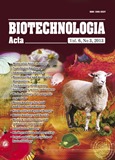ISSN 2410-7751 (Print)
ISSN 2410-776X (Online)

"Biotechnologia Acta" v. 6, no. 3, 2013
https://doi.org/10.15407/biotech6.03.046
Р. 46-52, Bibliography 19, Ukrainian.
Universal Decimal classification: 543.555 + 543.635.226 + 577.152.119
ENZYME CONDUCTOMETRIC BIOSENSOR FOR FRUCTOSE DETERMINATION
O. Y. Dudchenko1, 2, V. N. Pyeshkova1,
O. O. Soldatkin1, O. P. Soldatkin1, 2, S. V. Dzyadevych1, 2
1Institute of Molecular Biology and Genetics of National Academy of Sciences of Ukraine, Kyiv
2Institute of High Technologies of Kyiv National Taras Shevchenko University, Ukraine
The conductometric biosensor for fructose determination based on fructose dehydrogenase and potassium ferricyanide mediator as electron acceptor has been developed. The enzyme was immobilized on a surface of the conductometric transducer together with bovine serum albumin using crosslinking with glutaraldehyde. Working conditions of the discribed fructose biosensor were optimized. The results concerning influence of the buffer solution concentration and potassium ferricyanide concentration on the biosensor performance are given. The fructose biosensor is characterized by high signal reproducibility and selectivity to fructose. The developed conductometric biosensor can be successfully used for fructose monitoring in the procedures of food and clinical diagnostic.
Key words: conductometric biosensor, fructose, fructose dehydrogenase, potassium ferricyanide.
© Palladin Institute of Biochemistry of National Academy of Sciences of Ukraine, 2013
References
1. Dorokhovich V. Fructose has the highest sweetness among sugar substitutes. Khlibopek. konditer. prom. Ukrainy. 2011, N 1, P. 38–39. (In Ukrainian).
2. Barclay T., Ginic-Markovic M., Cooper P. D., Petrovsky N. The chemistry and sources of fructose and their effect on its utility and health implications. J. Excip. Food Chem. 2012, N 3, P. 67–81.
3. Strokova T. V., Zhurkova N. V., Pavlovskaya E. V., Kaganov B. S. Hereditary metabolic liver disease: 1. Violations of carbohydrate metabolism; 2. lysosomal storage diseases. Vopr. prakt. pediatr. 2009, 4(5), 28–37. (In Russian).
4. Guler A., Bakan A., Nisbet C., Yavuz O. Determination of important biochemical properties of honey to discriminate pure and adulterated honey with sucrose (Saccharum officinarum L.) syrup. Food Chem. 2007, 105(3), 1119–1125.
5. Lu J., Chen F., Xu H. et al. Standardization and quality control for determination of fructose in seminal plasma. J. Androl. 2007, 28(2), 207–213.
6. Anderson R., Reddy J. M. Jr., Oswald C., Zaneveld L. J. D. Enzymic determination of fructose in seminal plasma by initial rate analysis. Clin. Chem. 1979, 25(10), 1780–1782.
7. Birch G.G. Methods of carbohydrate analysis. Asean J. Sci. Technol. development. 1985, N 1, P. 88–97.
8. Tkac J., Vostiar I., Gemeiner P., Strudik E. Stabilization of ferrocene leakage by physical retention in a cellulose acetate membrane. The fructose biosensor. Bioelectrochemistry. 2002, V. 55, P. 149–151.
9. Parades P. A., Parellada J., Fernandez V. M. Amperometric mediated carbon paste biosensor based on D-fructose dehydrogenase for the determination of fructose in food analysis. Biosens. Bioelectron. 1997, 12(12), 1233–1243.
10. Ikeada T., Matsushita F., Senda M. Amperometric fructose sensor based on direct bioelectrocatalysis. Biosens. Bioelectron. 1991, V. 6, P. 299–304.
11. Parellada J., Dominguez E., Fernandez V. M. Amperometric flow injection determination of fructose in honey with a carbon paste sensor based on fructose dehydrogenase. Anal. Chim. Acta. 1996, V. 330, P. 71–77.
https://doi.org/10.1016/0003-2670(96)87686-0
12. Bassi A. S., Lee E., Zhu J.-X. Carbon paste mediated, amperometric, thin film biosensors for fructose monitoring in honey. Food Res. Intern. 1998, 31(2),?19–127.
https://doi.org/10.1016/S0963-9969(98)00071-4
13. Tkac J., Vostiar I., Gemeiner P. Fructose biosensor based on D-fructose dehydrogenase immobilized on a ferrocene-embedded cellulose acetate membrane. Anal. Chim. Acta. 2001, 439(1), 39–46.
https://doi.org/10.1016/S0003-2670(01)01021-2
14. Garcia C. A. B., Neto G., Kubota L. T. New fructose biosensors utilizing a polypyrrole film and D-frucrose 5-dehydrogenase immobilized by different processes. Anal. Chim. Acta. 1998, V. 374, P. 201–208.
https://doi.org/10.1016/S0003-2670(98)00259-1
15. Campuzano S., Loaiza O., Pedrero M. An integrated bienzyme glucose oxidase–fructose dehydrogenase–tetrathiafulvalene–3–mercaptopropionic acid–gold electrode for the simultaneous determination of glucose and fructose. Bioelectrochemistry. 2004, V. 63, P. 199–206.
https://doi.org//10.1016/j.bioelechem.2003.10.019
16. Miertus S., Katrlik j., Pizzariello A. Amperometric biosensors based on solid binding matrices applied in food quality monitoring. Biosens. Bioelectron. 1998, V.?13, P. 911–923.
https://doi.org/10.1016/S0956-5663(98)00063-3
17. Held M., Schuhmann W., Jahreis K., Schmidt H. L. Microbial biosensor array with transport mutants of Escherichia coli K12 for the simultaneous determination of mono-and disaccharides. Biosens. Bioelectron. 2002, V. 17, P. 1089–1094.
https://doi.org/10.1016/S0956-5663(02)00103-3
18. Kissinger P. T. Biosensors — a perspective. Biosens. Bioelectron. 2005, V. 20, P. 2512–2516.
https://doi.org/10.1016/j.bios.2004.10.004
19. Trivedi U. B., Lakshminarayana D., Kothari I. L. Amperometric fructose biosensor based on fructose dehydrogenase enzyme. Sens. Act. B. 2009, V. 136, P. 45–51.
https://doi.org/10.1016/j.snb.2008.10.020

